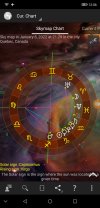I was mistaken,
@Pierre just informed me that the cataclysm of the
fall of the Roman empire likely happened around 540AD, not 79AD, so that alignment of gas giants does not correlate with the disasters mentioned above.
Hm, together with those two excerpts posted above:
Mexican House) Who was the last Roman Emperor before the fall of the empire?
(Pierre) Justinian?
(L) Probably. Was it Justinian?
A: Yes
(Pierre) So the link between the oppression committed by Justinian and the cataclysm, including the plague, would hold up.
(Pierre) I'm trying to reconcile the AD timeline of history and the BP timeline, ice cores and dendrochronology. There seems to be one matching marker at 536 AD - a year without summer, very cold, very bad weather - seemingly matching the 1500 BP mark with a converging cooling all over the planet revealed by ice cores and tree rings. So my question is: Is it a real match?
A: Yes
Q: (Pierre) In a previous session you mentioned about 470 years added between us and Julius Caesar. If it matches, it means these 470 years were added before 536 AD?
A: Yes
Q: (Pierre) It means Caesar died about 70 years before this 536 event?
A: Yes
Q: (Pierre) Wow. It means there's no late or middle Roman Empire!
A: Yes
the division to Eastern-Western Roman Empire comes to question.

I posed some questions about this subject already:
I've been wondering about above remarks and answers (bolded ones especially) about 'late Roman Empire' period which (supposedly) never really happened, at least that's how I understood the discussion during the session.
From this period, there were 'allegedly' such names and events like: emperor Constantine I the Great (ruled AD 306-337) with his 'cross in the heavens' and "In Hoc Signo Vinces" motto (AD 312/313), who later summoned and organized First Council of Nicaea (AD 325) where 'first official Christian canon' was established, and also division of Roman Empire to West-East (AD 395) [all dates/years taken from 'official' historical chronology] - some of the events that shaped and heavily influenced all the human world, and Balkans region in particular, especially the division of the Empire (later on taken as a basis for the boundary of Catholic and Orthodox East-West Great Schism, AD 1054) which can be felt even today in this area.
Official story goes that the Late Roman empire started with the rule of Diocletian in AD 284, who "weakened by illness, left the imperial office on 1 May 305, and became the first Roman emperor to abdicate the position voluntarily [which was very very strange by itself, and I think unheard of before]. He lived out his retirement in his palace on the Dalmatian coast, tending to his vegetable gardens. His palace eventually became the core of the modern-day city of Split (Aspalathos) in Croatia [2nd largest city in Croatia]". This palace in Split is even nowadays called Diocletian's palace.
So, questions running in my mind being like:
Are Diocletian and Constantine fictional figures?
If so, why would anybody with any 'sense' of fabrication make up such story of voluntary emperor's abdication (first in whole Roman history up to that date)?
Why would there be a story of Constantine organizing the Council and nevertheless 20+ years after the Battle of the Milvian Bridge vs. Maxentius? Are that battle and others, i.e. civic wars, also fictional stories, fabrications?
Why is there a story about division of the Empire if there was basically no Rome at that time, i.e. no dividing was needed if Eastern emperor could rule the whole Empire (no real rival was there in the ruined West)? And why put the border there where it allegedly was, when afterwards Eastern Empire (Byzantium) would take most of the Eastern Adriatic coast under it's rule, why not immediately draw a line to include whole coast under Eastern Empire?
And so on...
Well, I'm really shocked and confused by all this info from the session, and maybe I'm just trying to 'save' something that ought to be 'thrown away'...
So, to rephrase it sort of: Who would benefit from 'inventing' these 'historical events and persons', like Eastern-Western Roman Empire division?
Well, guys 'organizing' the Great Schism would be one possibility, to give credibility to Patriarch in Constantinople at the time, and more so as said above, the line where Schism 'happened' just happened to be the same line of Eastern-Western Roman Empire division. Nice coincidence. Greek enforcers come to mind.

Going further with this, taking a look at the name of the city where new pope should reside, Constantinople, named after another figure from the same period which could have been 'inserted' in our history line. Checking the
wiki for the names of that city not only I don't see any mention of Constantinople on coins from period in question, but also the usage of name Byzantium for that city on coins from 12th century:
The name Byzantius and Byzantinus were applied from the 9th century to gold Byzantine coinage, reflected in the French besant (d'or), Italian bisante, and English besant, byzant, or bezant. The English usage, derived from Old French besan (pl. besanz), and relating to the coin, dates from the 12th century.
Later, the name Byzantium became common in the West to refer to the Eastern Roman Empire, whose capital was Constantinople. As a term for the east Roman state as whole, Byzantium was introduced by the historian Hieronymus Wolf only in 1555, a century after the empire, whose inhabitants called it the Roman Empire (Medieval Greek: Βασιλεία τῶν Ῥωμαίων, romanized: Basileia tōn Rhōmaiōn, lit. 'kingdom of the Romans'), had ceased to exist.
On top of that, the name Byzantium was first used for Eastern Roman Empire in 1555 AD!

So, the name could have easily been
really invented and 'inserted' in the history. Certainly doing so would give more credibility to Byzantium, the real name of the city at that time, or so it seems. And what of wonderful opportunity to spice it a bit more with 'new great emperor' who just happened to 'accept' Christianity as official religion of Roman Empire during his reign, Constantine!
On quick glance, interesting thing about Constantine is that his story has some similarities with other historical figures, even maybe with Caesar (Rubicon - Milvian bridge, civil wars, ...), so he could have been invented. If that's so, there is no In Hoc Signo Vinces story and whole Christianity official religion of Roman Empire thing. Or, not under Constantine, that is.
Regarding Diocletian, he was also known for persecutions of Christians, one of them was Maurus of Parentium, Christian martyr to whom
Euphrasian Basilica in Poreč, Istria, Croatia, had been dedicated, and who died in cca 304 AD.
About St. Maurus, g00gle translate from
here:
He is the first known bishop of the Poreč diocese. During Diocletian's persecution, he was tortured and killed, along with his clergy and several lay believers, and buried in the early Christian suburban cemetery of Cimarè. His remains were transferred in the second half of IV. century in the oratory of the town church and laid in a stone sarcophagus, on which is engraved the Latin inscription HOC CVBILE SANCTVM - CONFESSORIS MAVRI - NIBEVM CONTINET CORPVS… (This holy resting place preserves the pure body of the martyr Maurus…). Bishop Euphrasius transferred them in VI. century in the newly built basilica and had his figure made in mosaic, in white robes, with a martyr's wreath in his hand.
About the Basilica, from wiki:
History
The earliest basilica was dedicated to Saint Maurus of Parentium and dates back to the second half of the 4th century.
The floor mosaic from its oratory, originally part of a large Roman house, is still preserved in the church garden. This oratorium was already expanded in the same century into a church composed of a nave and one aisle (
basilicae geminae).
The fish on the floor mosaic dates from this period. Coins with the portrayal of emperor Valens (365–378), found in the same spot, confirm these dates.
The present basilica, dedicated to Mary, was built in the sixth century during the period of Bishop Euphrasius. It was built from 553 on the site of the older basilica that had become dilapidated. For the construction, parts of the former church were used and the marble blocks were imported from the coast of the
Sea of Marmara. The wall mosaics were executed by Byzantian masters and the floor mosaics by local experts. The construction took about ten years. Euphrasius, holding the church in his arms, is represented on one of the mosaics on the apse, next to St. Maurus.
Martyr's remains were put there during emperor Justinian, when basilica was
really built.
Regarding coins in large Roman house with fish on floor mosaic, they are showing emperor
Valens' face, younger brother of
Valentian I (Valentian the Great) who gave him the reign over Eastern part of the Roman Empire (again the division theme).
Well, Poreč in Istria part of 'Eastern Roman Empire' in mid 4th century AD and division line 20 years later went on Drina river much further on the South of the Balkans? Strange, at least.
On another line, from wiki about Valentian I:
Valentinian was born in 321 at Cibalae in southern Pannonia (now Vinkovci in Croatia) into an Illyro-Roman family. Valentinian and his younger brother Valens were the sons of Gratianus Funarius, a prominent commander during the reigns of emperors Constantine I and Constans I. He and his brother grew up on the family estate where they were educated in a variety of subjects, including painting and sculpting.
There's more, on St. Maurus page (g00gle translate):
Forgetting the legend of the martyrdom of St. Mauro Porečki, in the Middle Ages began to celebrate the cult of the African monk of the same name, tortured in Rome for Emperor Numerian, whose remains allegedly spontaneously floated to the coast of Porec. This misunderstanding was corrected only after a plaque with a Latin inscription about the bishop of St. Mauro Poreč.
African monk, tortured in Rome, under Numerian who ruled Eastern part of the Empire (again the division theme).
From wiki:
Numerian (Latin: Marcus Aurelius Numerius Numerianus; died November 284) was Roman emperor from 283 to 284 with his older brother Carinus. They were sons of Carus, a general raised to the office of praetorian prefect under Emperor Probus in 282.
Again story of sons of a prominent commander.
A guess, not only part of Constantine story about the sign and Christianity (and Constantine's father) could have been 'borrowed/transferred' from Justinian (and his father), but also Valentian the Great could have been at least in part modeled upon Justinian?
There's also something about Christian martyrs and persecutions that's been bothering me, but can't pinpoint it yet.
Another great persecutor was Valerian, from wiki:
Valerian (/vəˈlɪəriən/; Latin: Publius Licinius Valerianus; c. 199 – 260 or 264) was Roman emperor from 253 to spring 260 AD. He persecuted Christians and was later taken captive by the Persian emperor Shapur I after the Battle of Edessa, becoming the first Roman emperor to be captured as a prisoner of war, causing shock and instability throughout the Roman Empire.
and Numerian father, emperor Carus, died in Persia, from wiki:
According to Zonaras, Eutropius, and Festus, Carus won a major victory against the Persians, taking Seleucia and the Sassanid capital of Ctesiphon (near modern Al-Mada'in, Iraq), cities on opposite banks of the Tigris.[13] In celebration, Numerian, Carus, and Carinus all took the title Persici maximi.[14] Carus died in July or early August of 283,[4] allegedly due to a strike of lightning.[15]
and Numerian also died there in strange way connected to eyes (wiki):
By March 284, Numerian had only reached Emesa (Homs) in Syria; by November, only Asia Minor. In Emesa he was apparently still alive and in good health, as he issued the only extant rescript in his name there.[19] Coins were issued in his name in Cyzicus at some time before the end of 284, but it is impossible to know whether he was still in the public eye by that point.[20]
After Emesa, Numerian's staff, including the prefect Aper, reported that Numerian suffered from an inflammation of the eyes and had to travel in a closed coach.[21] When the army reached Bithynia,[16] or Thrace,[22] some of Numerian's soldiers smelled an odor reminiscent of a decaying corpse emanating from the coach.[17] They opened its curtains and found Numerian dead.[23]
So, maybe Carus was copied from Valerian (or vice versa) or from whom ever Valerian was modeled about, i.e. both are made up, and Numerian also with them?
According to list of Christian martyrs (wiki):
Largely or wholly legendary
there is St. George (wiki):
Saint George (Greek: Γεώργιος (Geórgios); died 23 April 303), also George of Lydda, was a Christian who is venerated as a saint in Christianity. According to tradition he was a soldier in the Roman army. Saint George was a soldier of Cappadocian Greek origin and member of the Praetorian Guard for Roman emperor Diocletian, who was sentenced to death for refusing to recant his Christian faith. He became one of the most venerated saints and megalomartyrs in Christianity, and he has been especially venerated as a military saint since the Crusades.
which might suggest Justinian wanted to make his father a martyr and thereby a saint?
Another persecutor, Diocletian (wiki):
Diocletian (/ˌdaɪ.əˈkliːʃən/; Latin: Gaius Aurelius Valerius Diocletianus; born Diocles; 22 December c. 244 – 3 December 311) was Roman emperor from 284 to 305. Born to a family of low status in Dalmatia, Diocletian rose through the ranks of the military to become a cavalry commander of the Emperor Carus's army. After the deaths of Carus and his son Numerian on campaign in Persia, Diocletian was proclaimed emperor. The title was also claimed by Carus's surviving son, Carinus, but Diocletian defeated him in the Battle of the Margus.
Commander in army, ruling after Numerian and his father who died in Persia.
Persecuted Christians (
timeline) 20 years before Constantine brought Milan's Edict, like the coin in Basilica in Istria next to Trieste dedicated to St. Maurus who died in his persecutions predated 20 years Eastern-Western Roman Empire division, and like 20 years between Valerian's demise and Carus' death when Diocletian became an emperor.
It almost looks like Justinian's father was not a good person toward Christians in this version of the 'story' and Justinian 'wanted' to atone/expiate for that?
Another fake saint story according to wiki is that of St. Lawrence (wiki):
Saint Lawrence or Laurence (Latin: Laurentius, lit. "laurelled"; 31 December AD 225[1] – 10 August 258) was one of the seven deacons of the city of Rome under Pope Sixtus II who were martyred in the persecution of the Christians that the Roman Emperor Valerian ordered in 258. Lawrence encountered the future Pope Sixtus II, who was of Greek origin and one of the most famous and highly esteemed teachers, in Caesaraugusta (today Zaragoza). Eventually, both left Spain for Rome. When Sixtus became the Pope in 257, he ordained Lawrence as a deacon, and though Lawrence was still young appointed him first among the seven deacons who served in the cathedral church.
Suffered under Valerian together with pope of Greek origin in Rome - resembles a bit to that African monk suffered in Rome under Numerian who ended up in Persia story. 'Nice' coincidences again and Greek connection/enforcers signature maybe?
Another among Diocletian persecutions victims is St. Euphemia, name of the church and hill in Rovinj, city nearby Poreč (wiki):
Euphemia (Greek: Εὐφημία Late Koine Greek [efiˈmia]), "well-spoken [of]", known as the All-praised in the Eastern Orthodox Church, is a Christian saint, who was martyred for her faith in 303 AD. According to Christian tradition, this occurred at Chalcedon.
Miracle during the Council of Chalcedon
The Council of Chalcedon, the Fourth Ecumenical Council of the Christian Church, took place in the city of Chalcedon in the year 451. It repudiated the Eutychian doctrine of monophysitism, and set forth the Chalcedonian Definition, which describes the "full humanity and full divinity" of Jesus Christ, the Second Person of the Holy Trinity.
Present at the council were 630 representatives from all the local Christian Churches. The meetings were quite contentious, and no decisive consensus could be reached.
According to the Synaxarion of Constantinople, a collection of hagiographies, both parties wrote a confession of their faith and placed them on the breast of Saint Euphemia within her tomb. After three days the tomb was opened and the scroll with the Orthodox confession was seen in the right hand of St Euphemia while the scroll of the Monophysites lay at her feet.[1]
Saint praised in Byzantine region with church in Istria, and who's golden sarcophagus was allegedly put in church built by Constantine in Byzantium, died and performed her miracle during a Church Council across the Bosporus from Byzantium.
Going back to "who profits" from all that story-making, it seems Byzantium basically, church and city, Greek Enforcers.
So, any historical event/figure in time before the Schism might come under question, especially if in any way connected religion (Christianity in particular, but maybe even all monotheistic religions at the time?) and ruling power, like Roman emperors and Church Councils, determining the history line and religious dogmas, two powerful 'programming' avenues.
My two long cents/lipas.
Please mods, direct me if this has been discussed in detailed somewhere else and apologies for the noise in that case.


 the following 'configuration of gas giants is coming up in November 2024', last seen 79AD:
the following 'configuration of gas giants is coming up in November 2024', last seen 79AD:






